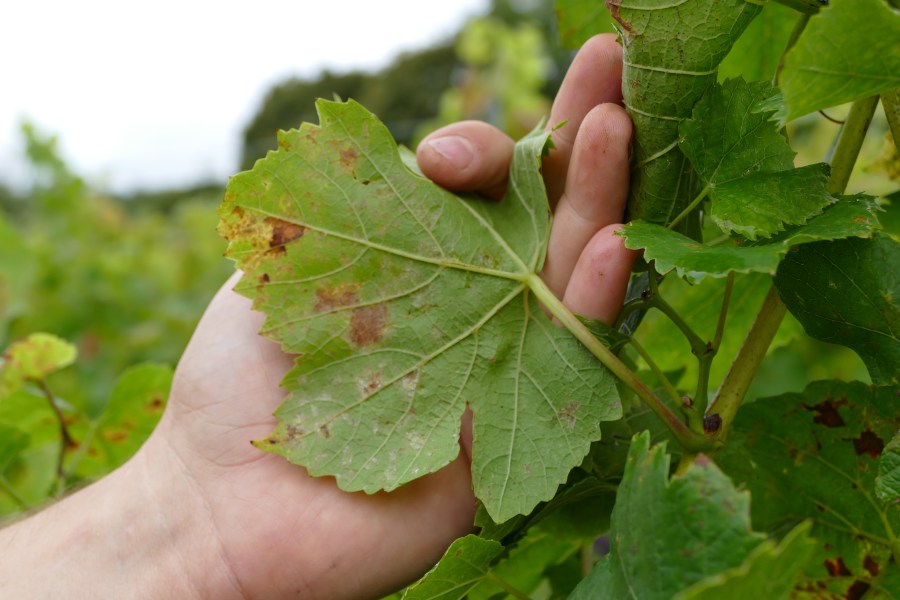The unsettled summer followed by a warm, humid start to autumn, has caused extremely high Downy mildew pressure throughout much of this season, plus a late surge of Spotted-Winged Drosophila (SWD).
Minimising disease carryover
Taking Downy mildew first. Many growers managed to keep the disease under control with good canopy management and well-timed fungicides. However, it did quickly flare up where sprays got disrupted due to the weather, or once fungicides had to stop being used due to the required harvest intervals on certain products.
The question now is what this means for disease risk going into next year. Crop pathology research shows a clear correlation between high levels of spore loading in one season and heightened disease risk the following year, so we must take steps to minimise disease carryover into next year.
Downy mildew spores, from fallen leaves, fruit and other infected plant material, overwinter in the soil and litter layer beneath vines, so strict vineyard hygiene will help reduce spore loading going into winter, ideally removing and burning plant material.
Of course that is not always possible on larger sites, and even where material is destroyed, there is still likely to be a high level of inoculum remaining in and around vines from spores that have already fallen onto the soil surface.
A post-harvest copper application is useful for managing risk, although there are two schools of thought in terms of the optimum timing. One is to apply copper soon after picking, to target the conidia spores present on leaves before they form closed fruiting structures called cleistothecia, which can be harder to control.
The alternative is to delay application until after leaf fall, thereby improving spray penetration onto the stems rather than the leaves, keeping stems mould-free while lignifying. There are pros and cons to both options, such as the risk of weather deteriorating before later sprays are applied, and the fact that much of the material will be pruned out over winter anyway. Equally, for early sprays, there is research suggesting copper may affect leaf breakdown by earthworms. It is therefore best to discuss the options with your agronomist.
Either way, Downy mildew risk is likely to be high going into 2024, so chemical and cultural control programmes will have to start early to stay ahead of any heightened infection risk.
SWD
Another talking point has been Spotted-winged drosophila (SWD), which has been reported in several crops around the country, including some well outside traditional hotspot areas in the south east.
Monitoring data shows numbers were actually at an eight-year low back in August, however last month’s warmth and humidity favoured a late rally, with untreated Pinot particularly affected, possibly because the pest is attracted to its sweet, red grapes.
SWD infection damages fruit, and plays an important role in spreading the bacteria involved in sour rot development, and keeping infection sites active – the resulting vinegar smell often attracts more SWD, which spread the problem further. This can have knock-on consequences for juice quality and the wine production process.
With a limited insecticide armoury available, and restrictive harvest intervals on key products, controlling SWD right up to harvest is a challenge that more growers may have to contend with in the future.
In-season monitoring is key to assessing the risks on individual sites, but still comparatively few growers do this. Alongside in-field monitoring traps, there are several virtual risk forecasts available, including the Omnia pest modelling service.
Colour change clues
Finally, as leaves change colour and start to fall, it may be worth just looking to see if there are any obvious differences in senescence and defoliation – beyond the natural variations that always exist – that could indicate an underlying issue with soil health, nutrition, or rooting.
A few sites showed some premature leaf yellowing earlier this year, which may have been a consequence of last year’s drought damaging some of the surface feeder roots, meaning vines were less able to extract nutrients from that zone. Roots should recover, but it’s worth keeping an eye on any affected areas.
Other sites may have different nutritional issues, so identifying suspect areas and prioritising those for more detailed soil testing over the winter could be more effective than following the standard “W-pattern” soil sampling protocol.




